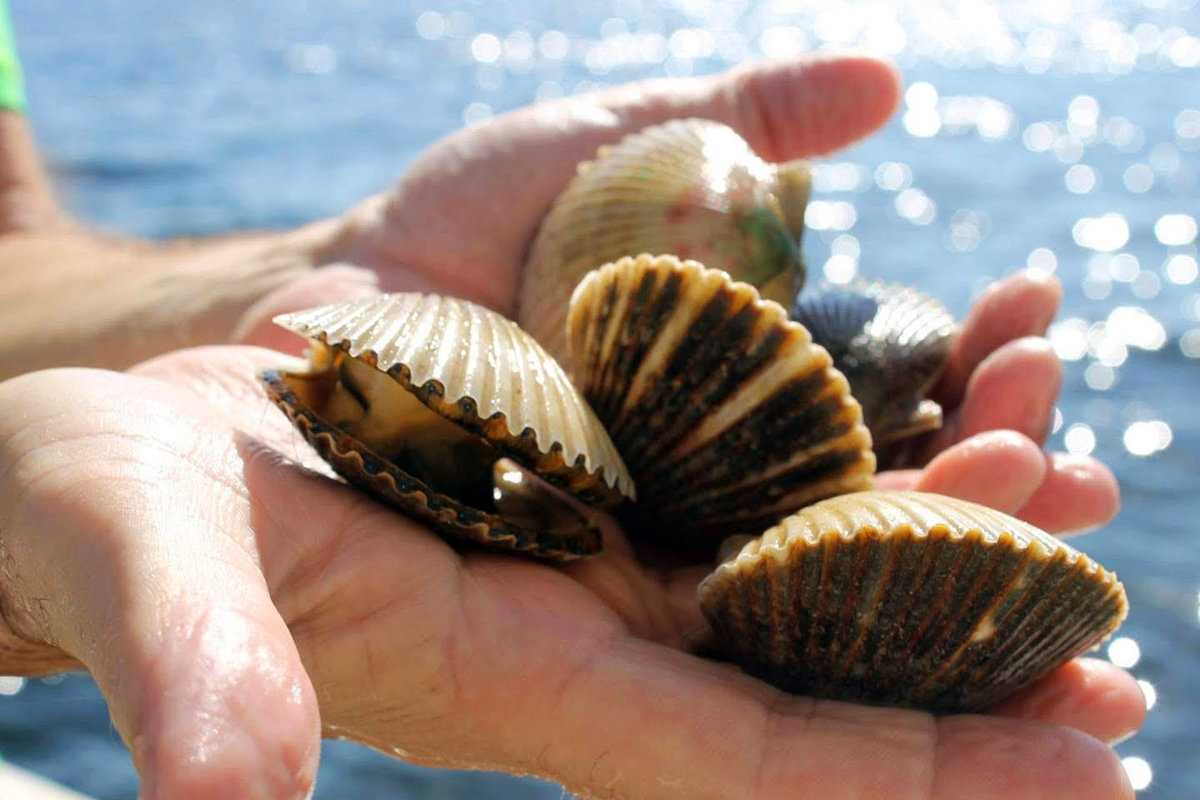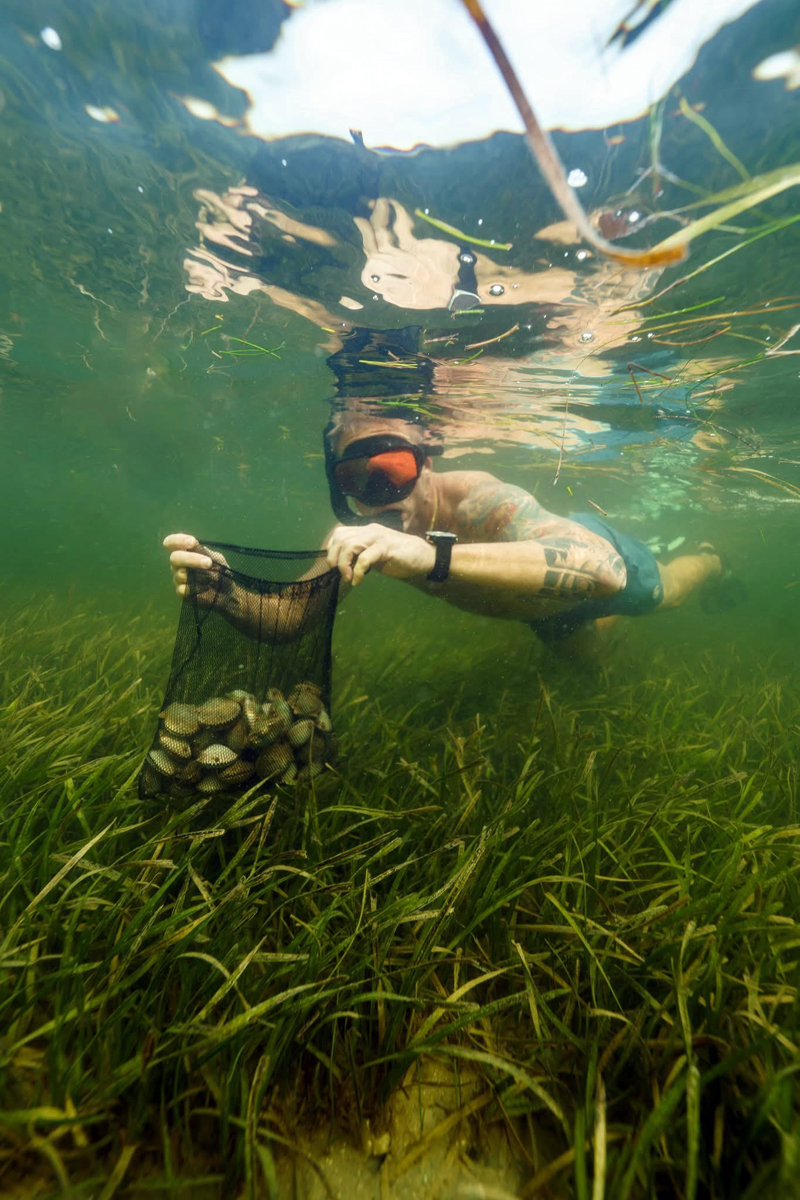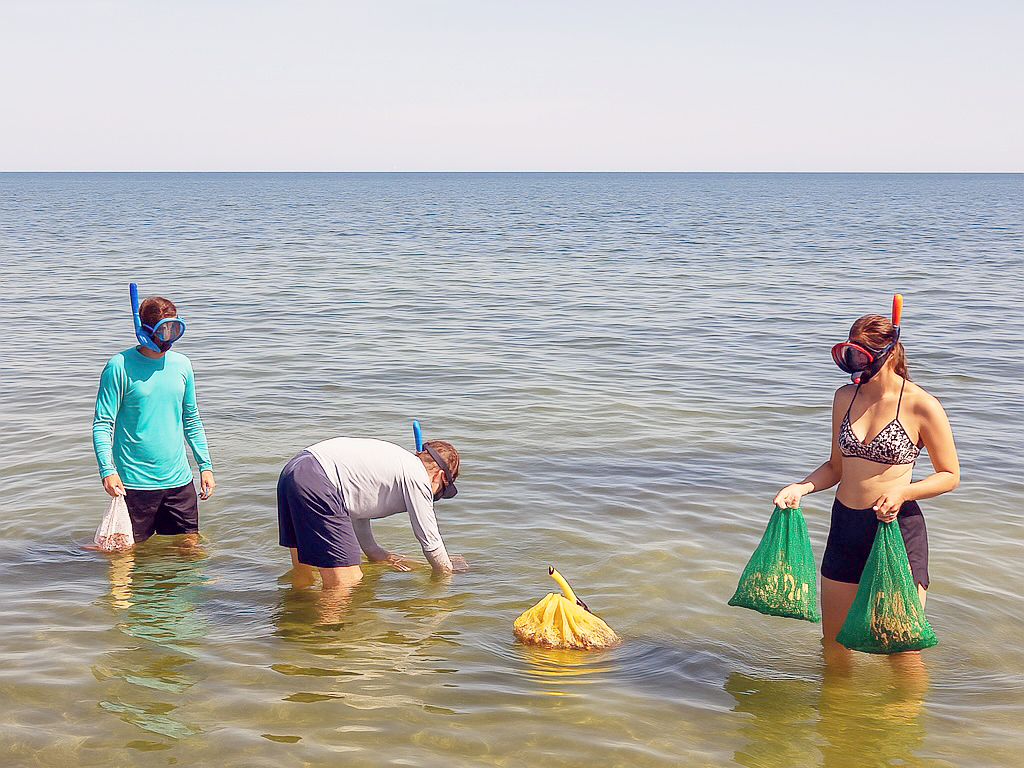Bay scallops are small shellfish that thrive in Florida’s seagrass beds, particularly along the Big Bend coastline. They are known for their distinctive fan-shaped shells and rows of bright blue eyes that line the edges of the shell. Scallops live only about one year in Gulf waters, with their life cycle peaking during the summer months. Because of this short span, scalloping seasons are carefully timed and managed.
These mollusks depend on healthy turtle grass and shoal grass for survival. Their presence in the Steinhatchee and Keaton Beach region reflects the overall health of the ecosystem. Scalloping is more than just a seasonal harvest; it connects visitors directly to the balance of the coastal environment.
Why Scalloping in Steinhatchee Is Popular
Scalloping in Steinhatchee attracts visitors for a variety of reasons. The activity combines food gathering, recreation, and the charm of a small Gulf town. Families, couples, and groups of friends can all enjoy this unique experience, and each summer the town becomes a hub of seasonal activity centered around the scallop harvest.

Harvesting Your Own Catch
The appeal begins with the simple satisfaction of collecting your own seafood. Scallops are picked by hand while snorkeling in shallow water. Bringing home a legal daily limit gives families and groups a sense of accomplishment and a connection to Florida’s waters.
An Activity for Families and Groups
Unlike many fishing methods that require skill with tackle or offshore equipment, scalloping is approachable. Children, parents, and grandparents can participate together by floating over grass beds with masks, fins, and snorkels. It provides a full-day activity that blends swimming, exploring, and harvesting.
A Seasonal Tradition
In Steinhatchee, scalloping is tied closely to summer. Town life reflects the rhythm of the season, with boats trailered in early, ramps busy by mid-morning, and marinas full of families heading out for the grass flats. Local businesses, lodging, and restaurants prepare each year for the return of scallop season, making it one of the area’s defining traditions.
The 2025 Season and Current Status
The season around Steinhatchee is managed as part of the Fenholloway through Suwannee Rivers Zone. Each year the opening and closing dates define when harvest is legal, and bag limits may shift during different parts of the season. Visitors planning trips must know these dates to avoid missing their window.
The waters around Steinhatchee fall within the Fenholloway through Suwannee Rivers Zone. In 2025 this zone opened on June 15 and runs through Labor Day, September 1. The early portion of the season, June 15 through June 30, had reduced bag limits. From July 1 through closing day, the regular limits apply.
As of August 19, 2025, the season is open and harvesters are active on the flats. The season will close after Labor Day. Other nearby zones opened later and continue through September 24, but Steinhatchee follows the earlier Labor Day closure.
Temporary closures sometimes occur in certain regions due to water quality issues. In 2025, for example, Pasco County waters were closed because of toxin concerns. While this does not apply to Steinhatchee, it underscores the importance of checking current conditions before heading out.
Rules and Regulations
Florida has clear rules that apply to scalloping, and these govern how scallops can be taken, how many can be harvested, and what is required to do so legally. Understanding these guidelines ensures that each trip is both safe and within the law.
Legal Gear and Methods
Scallops may only be collected by hand or with a small dip net. No mechanical devices are permitted. Harvest is strictly recreational, and commercial scalloping is not allowed.
License Requirements
Anyone harvesting scallops from a vessel must have a valid Florida saltwater fishing license. Exceptions apply only to certain residents under specific circumstances, such as wading without a boat. Visitors almost always need a license to participate legally.
Bag and Vessel Limits
During the main portion of the season:
- Each person may harvest up to 2 gallons of whole scallops in the shell, or 1 pint of shucked meat.
- Each vessel is limited to 10 gallons of whole scallops in the shell, or 1/2 gallon of shucked meat.
From June 15 to June 30, the reduced limits were 1 gallon per person and 5 gallons per vessel.

Boundaries
The Fenholloway through Suwannee zone includes all state waters east of Rock Island near the mouth of the Fenholloway River and north of Alligator Pass daybeacon #4 near the mouth of the Suwannee River. This area contains the productive grass flats around Steinhatchee.
Safety on the Water
Safety must be considered before any group enters the water. Florida law requires specific equipment, and trip leaders should review safety procedures with all participants. Proper preparation helps avoid common risks and ensures a safe outing.
Dive Flags and Signaling
Anyone snorkeling to collect scallops must have a divers-down flag or buoy. On the water, the flag must be at least 12 by 12 inches, while on a boat it must be at least 20 by 24 inches and displayed at the highest point. Divers must stay within 300 feet of the flag in open water and within 100 feet in rivers or channels. Boats must idle within those distances.
Life Jackets and Boat Safety
Every person on board must have access to a properly fitting Coast Guard–approved life jacket. Children under six must wear one at all times on vessels under 26 feet while underway. A throwable flotation device and signaling equipment are also required.
Weather and Tides
Summer in the Big Bend brings heat, sun, and afternoon storms. Checking the forecast each morning is essential. Groups should plan to return upriver before storms build. Incoming tides often bring the clearest water, while outgoing tides after rain can reduce visibility.
Preparing for a Trip
A successful day on the water depends on proper gear and preparation. Scalloping requires only simple equipment, but attention to detail makes the experience smoother and safer.
Personal Gear
Masks, snorkels, fins, mesh bags, and lightweight gloves cover the essentials. Rash guards or swim shirts protect from the sun, while hats and sunglasses provide comfort on deck. Bringing enough water and snacks prevents fatigue.
Boat Equipment
Divers-down flags, coolers, buckets, and safety kits must be ready before launch. Boats should carry ice to preserve the catch and anchor lines long enough to set properly without dragging across seagrass. Having extra gear such as spare flags or prop hardware prevents small setbacks from ending the day early.
Conservation and Etiquette
Steinhatchee’s grass flats support more than scallops. Protecting these habitats ensures future seasons remain productive. Visitors must balance enjoyment with responsibility to the environment.
Anchors should be set in sandy patches whenever possible. Propeller scarring damages grass beds and can take years to heal. Boaters should avoid discarding scallop shells in rivers where piles can harm habitats and navigation. Observing these practices protects both the fishery and the broader ecosystem.
The Lodge Experience
Guests of Econfina Sporting Lodge are located within easy reach of the Steinhatchee and Keaton Beach scalloping grounds. The lodge provides a convenient base for day trips, offering access to the heart of the season without long travel. Evenings at the lodge give visitors the chance to relax after a day on the flats, review their catch, and prepare for the next outing.
For many, the scalloping trip is about more than the harvest. It is a chance to spend time with family, enjoy Florida’s coastal beauty, and connect with the rhythms of summer. Steinhatchee delivers this experience year after year, and the lodge ensures guests are well positioned to take part.

Steinhatchee’s Seasonal Legacy
Each summer, scallop season transforms Steinhatchee into a lively hub where visitors and locals share the water, the town, and the traditions of Florida’s Big Bend. The activity blends recreation with conservation, providing a way for families to enjoy time together while participating in a practice that connects directly to the health of the region’s seagrass beds.
The experience does not end when the boat returns upriver. Evenings in town and at the lodge give visitors time to reflect on the day, share stories, and prepare for the next outing. This rhythm of mornings on the grass flats and afternoons returning to shore is what defines the scalloping season for so many people.
With the season still open, Econfina Sporting Lodge offers the ideal base for those planning a trip. Staying close to the grounds ensures that guests can make the most of the remaining days on the water. Book a stay now and secure direct access to one of Florida’s most anticipated summer traditions.


